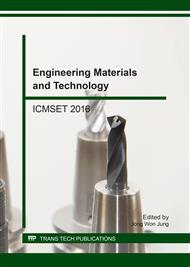[1]
P. Kajitvichyanukul, Environmental nanotechnology, first ed. Naresuan University Publishing House, Thailand, 2557.
Google Scholar
[2]
K. W. Busch, M. A. Busch, Laboratory studies on magnetic water treatment and their relationship to a possible mechanism for scale reduction, Desalination, 109 (1997) 131-148.
DOI: 10.1016/s0011-9164(97)00059-3
Google Scholar
[3]
Y. M. Hao, C. Man, Z. B. Hu, Effective removal of Cu(II) ions from aqueous solution by amino functionalized magnetic nanoparticles, J. Hazard. Mater. 184 (2010) 392-399.
DOI: 10.1016/j.jhazmat.2010.08.048
Google Scholar
[4]
W. Wu, Q. He, C. Jiang, Magnetic Iron Oxide Nanoparticles: Synthesis and Surface Functionalization Strategies, Nanoscale Res. Lett. 3(11) (2008) 397-415.
DOI: 10.1007/s11671-008-9174-9
Google Scholar
[5]
T. Puangmali, Magnetic Nanoparticles for Drug Targeting: A Magic Bullet for Cancer Therapy, KKU Sci. J. 41(3) (2013) 607-620.
Google Scholar
[6]
G. Kandasamy, K. Maity, Recent advances in superparamagnetic iron oxide nanoparticles (SPIONs) for in vitro and in vivo cancer nanotheranostics, Int. J. Pharm. 496(2) (2015) 191-218.
DOI: 10.1016/j.ijpharm.2015.10.058
Google Scholar
[7]
J. Xu, H. Yang, W. Fu, K. Du, Y. Sui, J. Chen, Y. Zeng, M. Li, G. Zou, Preparation and magnetic properties of magnetite nanoparticles by sol–gel method, J. Magn. Magn. Mater. 309(2) (2007) 307-311.
DOI: 10.1016/j.jmmm.2006.07.037
Google Scholar
[8]
N. J. Tang, W. Zhong, H. Y. Jiang, X. L. Wu, W. Liu, Y. W. Du, Nanostructured magnetite (Fe3O4) thin films prepared by sol–gel method, J. Magn. Magn. Mater. 282 (2004) 92-95.
DOI: 10.1016/j.jmmm.2004.04.022
Google Scholar
[9]
R. Strobel, S. E. Pratsinis, Direct synthesis of maghemite, magnetite and wustite nanoparticles by flame spray pyrolysis, Adv. Powder Technol. 20(2) (2009) 190-194.
DOI: 10.1016/j.apt.2008.08.002
Google Scholar
[10]
T. Iwasaki, N. Sato, K. Kosaka, S. Watano, T. Yanagida, T. Kawai, Direct transformation from goethite to magnetite nanoparticles by mechanochemical reduction, J. Alloys Compd. 509(4) (2011) L34-L37.
DOI: 10.1016/j.jallcom.2010.10.029
Google Scholar
[11]
E. H. Kim, H. S. Lee, B. K. Kwak, B. K. Kim, Synthesis of ferrofluid with magnetic nanoparticles by sonochemical method for MRI contrast agent, J. Magn. Magn. Mater. 289 (2005) 328-330.
DOI: 10.1016/j.jmmm.2004.11.093
Google Scholar
[12]
J. D. Obayemi, S. Dozie-Nwachukwu, Y. Danyuo, O. S. Odusanya, N. Anuku, K. Malatesta, W. O. Soboyejo, Biosynthesis and the conjugation of magnetite nanoparticles with luteinizing hormone releasing hormone (LHRH), Mater. Sci. Eng. C 46 (2015).
DOI: 10.1016/j.msec.2014.10.081
Google Scholar
[13]
P. A. Sundaram, R. Augustine, M. Kannan, Extracellular biosynthesis of iron oxide nanoparticles by Bacillus subtilis strains isolated from rhizosphere soil, Biotechnol. Bioprocess Eng. 17(4) (2012) 835-840.
DOI: 10.1007/s12257-011-0582-9
Google Scholar
[14]
K. Pornchanok, I. Kwanruthai, L. Paveena, Microstructure and magnetic properties of cobalt ferrites nanoparticles, MRC. MSU 10 (2014) 9-19.
Google Scholar
[15]
X. Sun, C. Zheng, F. Zhang, Y. Yang, G. Wu, A. Yu, N. Guan, Size-Controlled Synthesis of Magnetite (Fe3O4) Nanoparticles Coated with Glucose and Gluconic Acid from a Single Fe(III) Precursor by a Sucrose Bifunctional Hydrothermal, J. Phys. Chem. C 113(36) (2009).
DOI: 10.1021/jp9038682
Google Scholar
[16]
S. Xuan, L. Hao, W. Jiang, X. Gong, Y. Hu, Z. Chen, Preparation of water-soluble magnetite nanocrystals through hydrothermal approach, J. Magn. Magn. Mater. 308(2) (2007) 210-213.
DOI: 10.1016/j.jmmm.2006.05.017
Google Scholar
[17]
L. Ren, S. Huang, W. Fan, T. Liu, One-step preparation of hierarchical superparamagnetic iron oxide/graphene composites via hydrothermal method, Appl. Surf. Sci. 258(3) (2011) 1132-1138.
DOI: 10.1016/j.apsusc.2011.09.049
Google Scholar
[18]
X. Yang, W. Jiang, L. Liu, B. Chen, S. Wu, D. Sun, F. Li, One-step hydrothermal synthesis of highly water-soluble secondary structural Fe3O4 nanoparticles, J. Magn. Magn. Mater. 324(14) (2012) 2249-2257.
DOI: 10.1016/j.jmmm.2012.02.111
Google Scholar
[19]
P. Santi, L. Sarawuth, T. Chunpen, A. Vittaya, S. Ekaphan, M. Santi, Aloe vera plant-extracted solution hydrothermal synthesis and magnetic properties of magnetite (Fe3O4) nanoparticles, Appl. Phys. A 111(4) (2013) 1187-1193.
DOI: 10.1007/s00339-012-7340-5
Google Scholar
[20]
D. H. Chen, S. H. Huang, Fast separation of bromelain by polyacrylic acid-bound iron oxide magnetic nanoparticles, Process. Biochem. 39(12) (2004) 2207-2211.
DOI: 10.1016/j.procbio.2003.11.014
Google Scholar
[21]
F. He, D. Zhao, C. Paul, Field Assessment of carboxymethyl cellulose stabilized iron nanoparticles for in situ destruction of chlorinated solvents in source zones, Water Res. 44(7) (2010) 2360-2370.
DOI: 10.1016/j.watres.2009.12.041
Google Scholar
[22]
L. T. M. Hoa, T. T. Dung, T. M. Danh, N. H. Duc, D. M. Chien, Preparation and characterization of magnetic nanoparticles coated with polyethylene glycol, J. Phys. 187 (2009) 1-4.
DOI: 10.1088/1742-6596/187/1/012048
Google Scholar
[23]
K. Patcharin, R. Metha, R. Boonjira, Stabilization of magnetite nanoparticle with chitosan and chitosan network, NU Sci. J. 7(2) (2011) 60-70.
Google Scholar
[24]
K. Basavaiah, A. V. P. Rao, Synthesis of Polystyrensulfonic Stabilized Magnetite Nanoparticles, Chem. Sci. Trans. 1(2) (2012) 382-386.
Google Scholar
[25]
D. Liu, P. Wang, G. Wei, W. Dong, F. Hui, Removal of algal blooms from freshwater by the coagulation–magnetic separation method, Environ. Sci. Pollut. Res. 20(1) (2013) 60-65.
DOI: 10.1007/s11356-012-1052-4
Google Scholar
[26]
T. B. Wang, L. Liang, R. W. Wang, Y. Q. Jiang, K. F. Lin, J. M. Sun, Magnetic mesoporous carbon for efficient removal of organic pollutants, Adsorpt. 18 (2012) 439-444.
DOI: 10.1007/s10450-012-9430-2
Google Scholar
[27]
S. Laurent, D. Forge, M. Port, A. Roch, C. Robic, L. Vander Elst, R. N. Mullllelr, Magnetic iron oxide nanoparticles: Synthesis, Stabillization, Vectorization, Physicochemical Characterizations, and Biological Applications, Chem. Rev. 108 (2008).
DOI: 10.1021/cr068445e
Google Scholar
[28]
C. Y. Haw, F. Mohamed, C. H. Chia, S. Radiman, S. Zakaria, N. M. Huang, H. N. Lim, Hydrothermal synthesis of magnetite nanoparticles as MRI contrast agents, Ceram. Int. 36(4) (2010) 1417-1422.
DOI: 10.1016/j.ceramint.2010.02.005
Google Scholar
[29]
C. Nucharee, B. Tripob, B. Darunee, Remanent Magnetization characteristics of Synthetic Magnetic Nanoparticles, KKU Res. J. (GS) 9 (2009) 48-56.
Google Scholar


